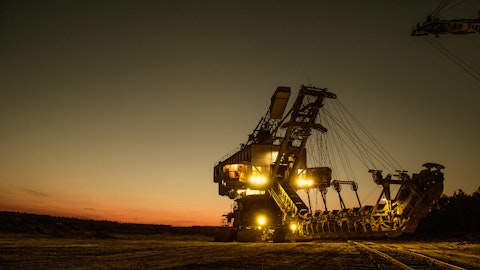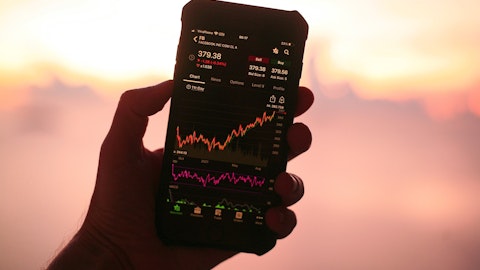Roy Harvey: Yes. I can provide some color, Mike. As always, every customer might be a little bit different, so I will try and generalize a little bit. We are still seeing a lot of strength in the U.S. market, particularly. And so when we look across the different product categories, and I would highlight transportation and packaging is the two places where we are just seeing €“ we continue to see more demand than probably we are able to fulfill. So, the U.S. market is still running very well. In Europe, I think there is a lot more uncertainty. Some of that uncertainty, I think has started to step back a little bit just because of the reduction in gas prices and the reduction in electricity prices that we are seeing. There has been a certain amount of destocking, so I think that our customers have been taking the position that they are, being very careful what they order.
And in Europe, we tend to contract on a quarterly basis. And so you would tend to see those reactions happen a bit quicker than what you might see in the U.S. But I think there is now, I would argue, more uncertainty in the market about whether we will start to see a better recovery. And you have probably seen as well as I have some of the analyst coverage about the potential for recovery in Europe because it’s been such a mild winter and because they are €“ they have sufficient gas and storage. And so I would say there has been a cautious approach in Europe, but I think it’s also potentially constructive as we see what happens over these next few critical weeks and these next few critical months. From a Chinese perspective, and we don’t sell particularly into China, but I think that has a knock-on impact what people are seeing there, I think there is a general expectation that they need to work through this abrupt opening of €“ or loosening of COVID restrictions.
I know there is plenty of discussions about how much industrial activity is able to happen between now and the Chinese New Year. We have also seen a lot of issues on the supply side, particularly when it comes to aluminum, just because of the availability of energy between droughts and hot weather and all sorts of things, it hasn’t been an easy time to see stable operations in China, particularly in smelting these days. And all that sort of will culminate then coming out of the Chinese New Year. We are coming into it, and I just saw a headline today saying that we are relatively a very low inventory build coming into Chinese New Year, which then bodes very well if we see that demand recover and we start to come out of sort of what might be the spike in cases of COVID because of the loosening of COVID restrictions.
It really does bode well for demand coming out of China and because of the size of the Chinese market that then bodes well for all of the global markets when it comes to aluminum. So, certainly, a lot of the things I have been seeing recently are providing a lot of breadcrumbs that say, €œHey, there is still a significant amount of uncertainty.€ We come out of what’s been a relatively small deficit for the aluminum market in 2022 into a market where there is a lot of uncertainty, but I would argue that over these last weeks, we have been seeing more and more positivity come out. Again, that’s €“ you always take into account what could happen in Ukraine, what’s happening across the world when it comes to demand, etcetera. But I look at our business and I look at our customers, and we are still finding good uptake of our value-added products.
We continue to see good improvements on our low-carbon offerings as well. And that’s a piece of the market. It’s particularly developed inside of Europe. But to me, that sort of gives you good positive signs that we are continuing to see a constructive market. And that even if there are some short-term disturbances when we look into the medium and long terms, I am very positive about what’s going to happen across our markets.
Michael Dudas: Thank you.
Roy Harvey: Thank you, Mike.
Operator: Our final question comes from John Tumazos with John Tumazos Independent Research. Please go ahead.
John Tumazos: Thank you. Looking at ELYSIS and the Refinery of the Future, what is the likely first location where you would retrofit a smelter or retrofit a refinery? And what year might we look ahead to that? Is it possible for 2025 or sooner or later?
Roy Harvey: So, it’s a great question, John, and not one that we have yet defined and certainly not communicated. And so we are looking across all the jurisdictions where we operate. As you can imagine, there is a lot of excitement about ELYSIS and a lot of excitement about who can be first. Canada of course, is one of the frontrunners because they have been so supportive of the technology, the technology as an investor, as supporting all of the work that’s being done in Canada right now. And obviously, they have a very attractive energy scheme as well. But I wouldn’t count out the U.S. as a potential location. Norway is another great place where we have had a lot of support from the government in a lot of different places. And so I would say that it is still very much open where that first application will happen.
And to be quite honest, as we watch the good results come in here over the course of 2023, it’s going to get more and more of an opportunity for us to decide where will that first application be. And as to when that first one will be built, what we have been saying is that by the end of 2024, we want the engineering package in place so that first metal can come out in 2026. So, it says we really need to get started building in €“ across €˜24 and €˜25. So, it doesn’t give us a lot of time. It means we are coming up on a decision where that first location will be. It means we need to be interfacing with all of our host governments and our potential host governments and need to continue to see good progress on the actual success of those industrial-scale cells that are being operated today.
John Tumazos: As far as Refinery of the Future, yes?
William Oplinger: Yes. As far as Refinery of the Future goes, John, and I will address that one quickly. Remember that Refinery of the Future is really a suite of processes that we are developing. Out of that suite of processes, there are some that we have talked about externally, for instance, mechanical vapor recompression and electric calcination. We have committed to do a pilot of mechanical vapor recompression in 2023 at the Wagerup facility, and we are getting some funding from the Australian government. Out of the $115 million that we are talking about return-seeking capital, MVR is included in that $115 million. So, while we have skinnied down our return-seeking and our sustaining capital, there are a handful of projects that are really critically important for us and MVR is one of them, and that’s included in those numbers.
As far as electric calcination, it’s a little bit farther away, and we need to prove out the technology at a smaller scale. So, it’s too early to say where that would be applied.





